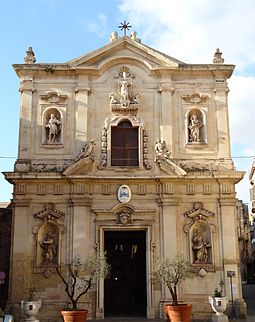Archbishop of Taranto
|
Archdiocese of Taranto Archidioecesis Tarentina |
|
|---|---|

Taranto Cathedral
|
|
| Location | |
| Country | Italy |
| Ecclesiastical province | Taranto |
| Statistics | |
| Area | 1,056 km2 (408 sq mi) |
| Population - Total - Catholics |
(as of 2014) 412,500 415,500 (est.) (99.3%) |
| Parishes | 88 |
| Information | |
| Denomination | Catholic Church |
| Rite | Roman Rite |
| Established | 6th century |
| Cathedral | Basilica Cattedrale di S. Cataldo |
| Secular priests | 155 (diocesan) 65 (Religious Orders) |
| Current leadership | |
| Pope | Francis |
| Archbishop | Filippo Santoro |
| Emeritus Bishops | Benigno Luigi Papa, O.F.M. Cap. |
| Map | |
 |
|
| Website | |
| www.webdiocesi.chiesacattolica.it | |
The Archbishopric of Taranto (Latin: Archidioecesis Tarentina) is a metropolitan Roman Catholic diocese in southern Italy, on a bay in the Gulf of Taranto.
Its suffragan sees are the diocese of Castellaneta and diocese of Oria. The current Archbishop of Taranto is Archbishop Filippo Santoro, appointed by Pope Benedict XVI on 21 November 2011 to replace Archbishop Benigno Luigi Papa, O.F.M. Cap., whose resignation was accepted that same day.
In a local Tarantine legend, according to a document of the XI or XII century, the Gospel was preached in Taranto by St. Peter the Apostle. He had arrived in the city in AD 45, along with Saint Mark, on their way to Rome. Amasianus was a gardner or greengrocer, whom Peter converted to Christianity. It is only later, much later, that the Tarentines claim that Amasianus was consecrated a bishop. It is also stated that St. Cataldus was consecrated by St. Peter the Apostle. Whether Amasianus was the first bishop of Taranto, or whether it was Cataldus, in whose honor the Cathedral is dedicated, seems to be a pointless inquiry. As Lanzoni remarks, the stories are full of fables. The real Cataldus was an Irish bishop from Rachau (or Rachan) of the VI century, who happened to die in Taranto during his pilgrimage to the Holy Land.
The city also honors the martyr St. Orontius. Interestingly, Orontius, the son of an Imperial treasurer, had been converted to Christianity by Justus, a disciple of St. Paul, who had landed at the port of Saint Cataldus, and preached to the population in the locality of Lecce in the time of Nero, despite harassment by imperial officials. They returned to Corinth, where St. Paul consecrated Orontius the first Bishop of Lecce, and the party returned to Lecce to continue their evangelization.
The first bishop whose date is known is Petrus (not Innocentius) (496). In the pontificate of St. Gregory the Great (590–604), the names of three bishops who filled the episcopal chair are known: Andreas (590), Joannes (601), and Honorius (603). Archbishop Joannes (978) is the first who had the title of archbishop.
...
Wikipedia
